Hey there, Great forum you've got going here - very helpful! I'm a long time lurker, first time poster.
I'm about to embark on fulfilling a lifelong dream of a dedicated studio/music/rock-god-lair m/, I've read Rod Gervais' book - plus other articles...and many threads here so I think I have the fundamentals happening?
It's going to be a one room affair - with the main intention of being able to play/record guitars (loud!) and vocals without annoying the neighbours too much (not sure what that equates to in dB?). It is a hobby and not a livelihood - so I don't need to go to the nth degree, but I do want to do it well. I'm guessing my budget is in the order of $10k - as I'll be doing most of the work by myself..with a little help from my friends.
The walls are all brick, the roof is concrete tiles. The main panel door is going to go and be replaced with a cement sheet clad (x2 layers) stud wall.
I'm planning to use about 2/3 of the overall space. I want to leave a workshop at the back.
I have a neighbour about 5m to the right (you can just see their roof in the second pic above), but that's my only real concern on that front.
The basic design looks like this.
So the plan is to build a 'room within a room' and to add treatment once finished. The floor is a concrete slab. One of the side walls has a lounge room on the other side, that's the wall with no stud wall in the studio. My thought there was that with there being a stud wall on the inside of the house, that constituted a two leaf system, so I was going to simply add plasterboard directly to the bricks on the studio side to beef it up - does that work?
A question about the internal wall - I was thinking that and the rear external wall would form a 2 leaf system - but the air gap will be a workshop with stuff in it. Would I be better off adding a 2nd leaf to that internal wall, i.e. plaster on both sides...or does that then set up the dreaded 3 leaf system?
The ceiling is pretty low - 2330mm - so that could present some problems, but the overall dimensions of the room are reasonably generous, so I figure that should counter that to some degree(?).
Anyway, I'm someone could chime in with thoughts on the design at this stage - point out any glaring problems or potential pitfalls - or any other information I've left out. That would be greatly appreciated.
The only thing I haven't fully worked out is HVAC. I was looking for a low cost option...which is proving difficult to do in Aus. Ideally, I'd put in the Daikin split that has air intake...but at around $2k locally, I don't forsee that happening and I can't seem to find any 2 hose portable aircon units available here. So I may end up with a hybrid system consisting of an intake with a fan via a baffle and a passive return (again baffled), along with a smaller split system to handle cooling and help with humidity. Thoughts?
Cheers,
Scott
Comments
Hey Space, Thanks for the reply...much appreciated! Space, pos
Hey Space,
Thanks for the reply...much appreciated!
Space, post: 420212, member: 32398 wrote: If the work shop is open and active then you would be better off applying two layers of 5/8 fire rated sheetrock on the side in question. If the room will be dormant when you are using the recording side, then it should not be a specific issue...depending on your isolation requirements
The workshop will be mostly dormant as I'll be in the studio...so I reckon I'll leave it. If i need more isolation, then working on the window and door on that back wall are going to be my first points of concern. The level of isolation I'll need will not be large - I don't envisage any late night band sessions or drum kit recordings into the wee small hours....in fact probably no drum kits...just loud guitars!
The dimensions of the room are; height 2.3 m, width 4.5 m length 5.69m. I think the height is really my limiting factor here, but I don't want to go smaller on the room size if I can avoid it. I've been looking a lot at good room ratios and mode calculators, but I haven't landed on anything that seems to work really well as far as 'maximise the space vs maximise mode separation/distribution'.
Space, post: 420212, member: 32398 wrote: But you are missing the big picture. Isolation, specifically room-in-room design is 3D. You have not explained how you are going to construct the ceiling in this building.
As far as the ceiling is concerned - I plan to get a couple of layers of 16mm sheetrock up there, with a layer of rockwool insulation on top of that. There are wooden joists that span the room from front to back. I don't like the idea of hanging that much stuff of resilient channel - so I was going to give that a miss, but may consider Green Glue between the layers as I think the ceiling/roof is my achilles heal? I will also need to do lots of sealing of gaps (like in the pointing and side wall on the house side) up in the roof cavity as well.
Space, post: 420212, member: 32398 wrote: Also, to what end are you making framed walls with insulation to the left hand side of this picture?
The framed insulation on the side wall...all of the descriptions and diagrams of the double wall have rockwool (or similar) in the frame of each wall/leaf (like on pg 63 of Rod's book). I was just following that...and considered that would constitute part of the outer leaf...? Is that sound thinking or am I better to just leave it as air gap...or another suggestion?
here's some thing I would think about it it were me. Wall wall
here's some thing I would think about it it were me. Wall wall space ends up eating up a lot so I'd minimize them by forgetting the lounge you can put a chair anywhere. What you really need is a porcelain chair, with a sink. This my friend will come in far more handy. Maybe cut the workshop in half?
I'm not being negative but once you add a Daw and desk a couch a mini fridge, panels, figure all the ISO wall space taken up, a table, your buddy's rig, all that stuff it makes rooms seem small fast. If you've ever been to a band practice space u know what I mean, crap everywhere. Studios too, same thing. Storage and bathrooms are way too often underestimated. Mic Stands,pedals, crap adds up. Look at how much text it took! Lol. If it's been a lifelong dream do it right. Forget the workshop. Make a music room. Put a tool bench in the basement make a workshop there. The requirements for a workshop are far less stringent than for a studio. Just my 2 cents
How loud do you play full stack ? Fender combo? Does your budget include gear, or is that building materials only?
Scott Watkins, post: 420221, member: 48530 wrote: The framed ins
Scott Watkins, post: 420221, member: 48530 wrote: The framed insulation on the side wall...all of the descriptions and diagrams of the double wall have rockwool (or similar) in the frame of each wall/leaf (like on pg 63 of Rod's book). I was just following that...and considered that would constitute part of the outer leaf...? Is that sound thinking or am I better to just leave it as air gap...or another suggestion?
You misinterpret what it is you are seeing. All the descriptions and diagrams of the double WOODEN FRAMED wall have rockwool (or similar) in the WOODEN frame of each WOODEN wall/leaf.
The insulation in these wood framed walls damp the sheetrock, reducing the vibration and the insulation does stop mid/high frequency. With a concrete exterior the ability of sound to vibrate the "panel" (concrete wall) takes a lower frequency than it would for a light weight sheetrock sheathed wooden framed wall assembly.
So I say put the insulation in the wood framed walls but spend your money somewhere else in respect to the insulation on the concrete wall.
Hey KMetal, I hear you, but there's no basements here in Oz, so
Hey KMetal,
I hear you, but there's no basements here in Oz, so nowhere else to have a workshop...and I want that as well! Plus there's other people who live here and have a say in things:) I have some storage arrangements elsewhere.
Currently I'm rockin' a 2 x 12.
Space, post: 420263, member: 32398 wrote: So I say put the insu
Space, post: 420263, member: 32398 wrote:
So I say put the insulation in the wood framed walls but spend your money somewhere else in respect to the insulation on the concrete wall.
Well that's good news...I like the 'less expensive' variety of advice.
Any thoughts on room dimensions?
Is the 2.3m ( 7' 6 1/2" ) to the bottom of the joist or the top?
Is the 2.3m ( 7' 6 1/2" ) to the bottom of the joist or the top? If it is to the bottom I need to know what it is to the top since this will be the defining dimension (the height is usually the controlling factor in these cases).
The measurements you gave they are of the existing structure is that correct?
It's 2335 mm from the floor to bottom of the joist. The joist di
It's 2335 mm from the floor to bottom of the joist. The joist dimensions are 100 mm x 35 mm. The dimensions I was quoting were of the room as I had planned it to date. Check the attached pic. which gives the overall dimensions of the room as 4756 x 5035 mm. 4756 mm being the max width I want to go to.
Rather than me drawing this from scratch would you email the ske
Rather than me drawing this from scratch would you email the sketchup to me?
email:brienholcombe@gmail.com
Rather than me drawing this from scratch would you email the ske
Rather than me drawing this from scratch would you email the sketchup to me?
email:brienholcombe@gmail.com
Sketchup 14? Wow...I had to do some conversions to get it to the
Sketchup 14? Wow...I had to do some conversions to get it to the current "free" version of version 8 :)
Give me a couple of days or so, I have to redraw the complete interior...so that can take a bit.
You posted this job over at johnlsayers too, right? So rather than me reply in both forums to the same things, I will work from this forum...since this is my jumping off point so to speak.
Sweet - I really appreciate your help on this! This is the free
Sweet - I really appreciate your help on this!
This is the free version of Sketchup as far as I know...? I certainly didn't pay for anything (or do any illegal downloads..!). Yep, on the Sayers forum as well, happy to keep it here for sure.
I've been trying to nut through what to do on the HVAC front. So far I've had some thoughts on the ventilation side of things, by utilising an in-line fan of some description (TBC), a silencer and a passive return venting to inside the roof cavity. As far as AC is concerned I think the best option is go a smallish split system - mount the head on the 'back' wall (facing us in the diagram below).
Fan like this sort of thing:
http://www.pureventilation.com.au/product/in-line-fans/tt-pro-mixflow-in-line-fan-200mm-w-lead-plug/
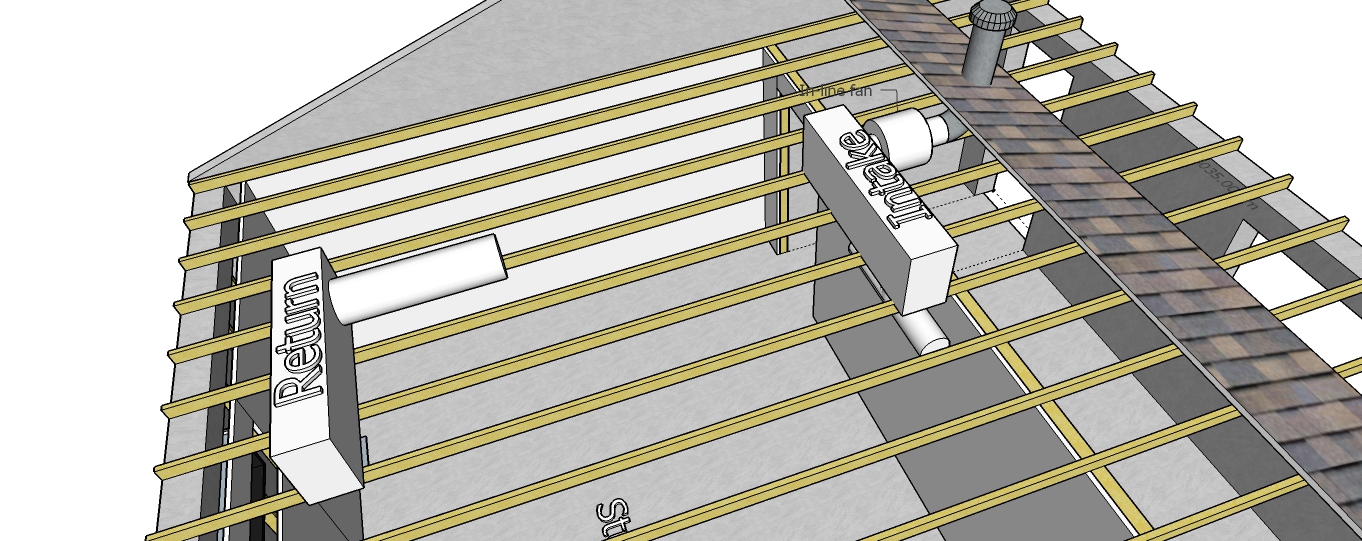
Silencer design: Courtesy of someone on the JohnlSayers forum.
Scott Watkins, post: 420440, member: 48530 wrote: I've been tr
Scott Watkins, post: 420440, member: 48530 wrote:
I've been trying to nut through what to do on the HVAC front. So far I've had some thoughts on the ventilation side of things, by utilising an in-line fan of some description (TBC), a silencer and a passive return venting to inside the roof cavity. As far as AC is concerned I think the best option is go a smallish split system - mount the head on the 'back' wall (facing us in the diagram below).
What ever you do, you want the send side of the HVAC and the return side of the HVAC to be on opposite corners of the room, not directly across the room one from the other.
This is a down and dirty look at how your interior wall framing
This is a down and dirty look at how your interior wall framing should look. You notice it is not attached to any part of the exterior. This is, at least as the walls are concerned, the mass/air/mass component that you have read about.
As a system, mass/air/mass requires the entire environment to be developed in this way, exterior hard boundary /air/ interior hard boundary, and exterior roof hard boundary /air/ interior ceiling hard boundary.
This process that I am showing with a picture is how you develop a fully decoupled wall assembly. It is usually completed using OSB (orientated strand board) in the Americas but 4 ply plywood can do the job for the matter of structural stability.
There may be the need for several decoupling fasteners in the long parts of the walls, but over all you have a decoupled interior versus a none decoupled environment.
Awesome - appreciate you taking the time. Taking that on board
Awesome - appreciate you taking the time.
Taking that on board - Check the latest design, which is essentially exactly what you said...
Which makes the internal dimensions H:2300 W:4235 L:5600 mm
Also, RE Ventilation. Going to make the intake passive and the return active (inline fan as specified earlier), and place the intake over near the door (in the ceiling) and the return near the diagonally opposite corner (left of the window in the top pic.) - ceiling mounted as well. does that sound like a better arrangement - I'll update the details of that on the diagram shortly.
Again - thanks for the help.
" and place the intake over near the door (in the ceiling) and t
" and place the intake over near the door (in the ceiling) and the return near the diagonally opposite corner (left of the window in the top pic.)"
Saying intake and return sounds like the same thing. Return is the side that pulls out bad air, so I agree with placement but I would rather it lower on the wall and closer to the floor rather than over head and potentially becoming a source of energy for a microphone.
Space, post: 420788, member: 32398 wrote: Saying intake and ret
Space, post: 420788, member: 32398 wrote:
Saying intake and return sounds like the same thing. Return is the side that pulls out bad air,
Yes - by 'intake' I meant...'fresh air supply'.
Space, post: 420788, member: 32398 wrote: so I agree with placement but I would rather it lower on the wall and closer to the floor rather than over head and potentially becoming a source of energy for a microphone.
Yep - good call - I think it will be possible to do as I have a reasonable size cavity in that side wall (left wall in top pic) - I'll look at doing that. Thanks.
I was thinking 150mm or 200mm ducts is that big enough/too big...depends?
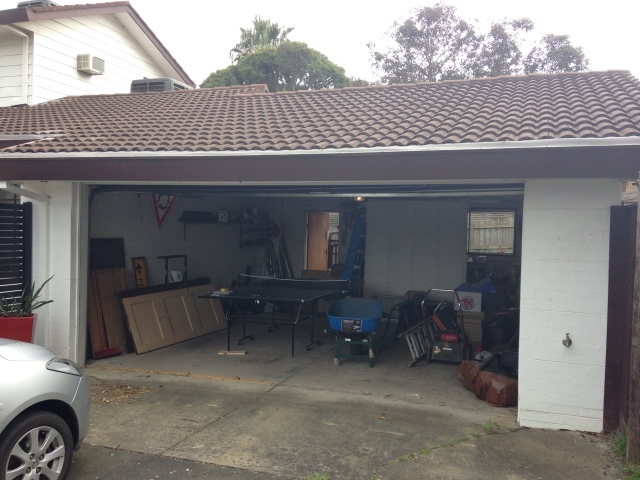

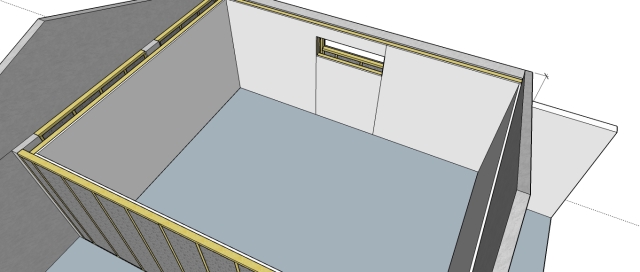
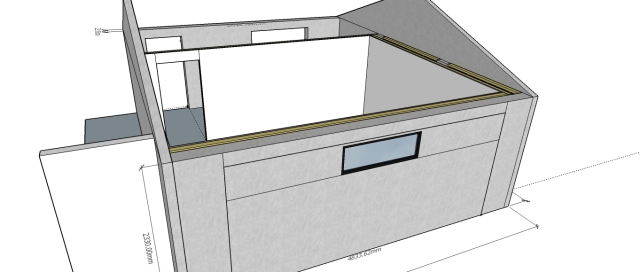
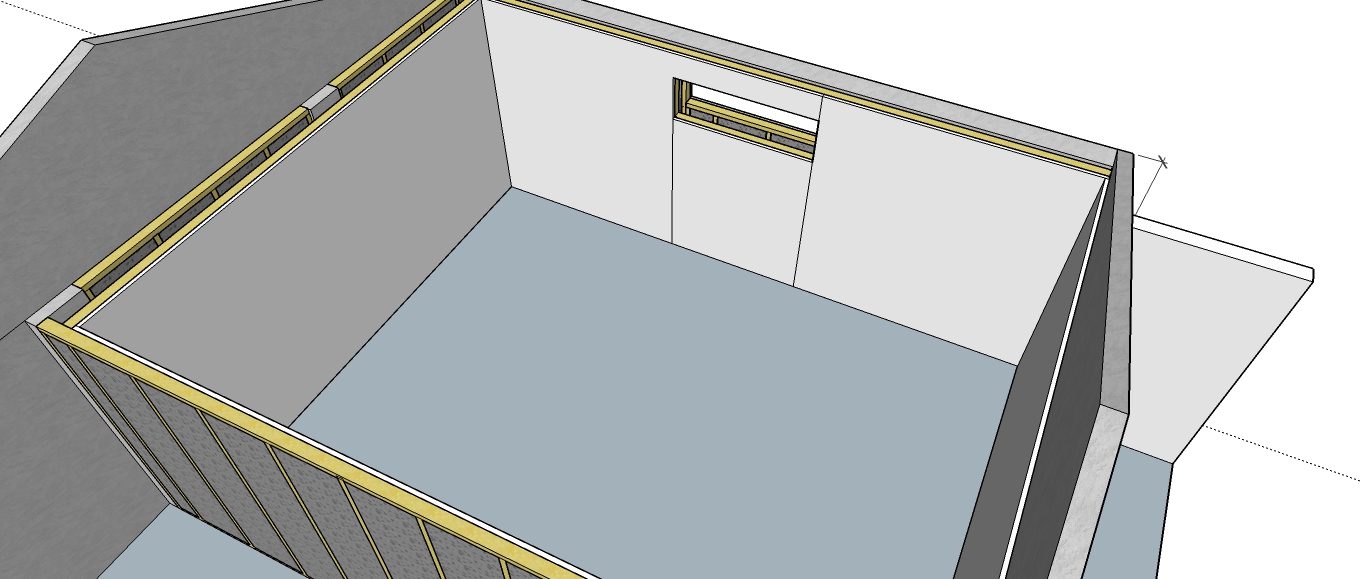







"Would I be better off adding a 2nd leaf to that internal wall,
"Would I be better off adding a 2nd leaf to that internal wall, i.e. plaster on both sides...or does that then set up the dreaded 3 leaf system? "
The dreaded 3 leaf exists like spiders do...they are everywhere. The bigger the air space the better off you are. The thing to take into consideration is this. If the work shop is open and active then you would be better off applying two layers of 5/8 fire rated sheetrock on the side in question. If the room will be dormant when you are using the recording side, then it should not be a specific issue...depending on your isolation requirements.
"but the overall dimensions of the room are reasonably generous" We would like to know what they are...you may can develop a better room with a few tweaks.
But you are missing the big picture. Isolation, specifically room-in-room design is 3D. You have not explained how you are going to construct the ceiling in this building.
Also, to what end are you making framed walls with insulation to the left hand side of this picture?